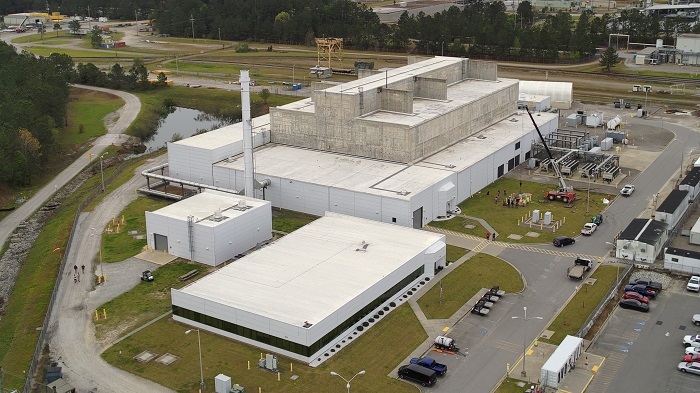  Savannah River Site Tops 15 Million Gallons
of Salt Waste Processed
AIKEN, S.C. — The Savannah River Site’s (SRS) liquid waste
program has processed more than 15 million gallons of radioactive salt waste
since 2008 through the work of three major facilities. To reach this milestone of 15 million gallons processed, SRS has
relied on the Salt Waste Processing Facility (SWPF) for the past three years, along with
the past performance of the Actinide Removal Process/Modular Caustic Side
Solvent Extraction Unit (ARP/MCU) and Tank Closure Cesium Removal (TCCR). Radioactive liquid waste is generated at SRS as byproducts from
processing nuclear materials for national defense, research, medical
programs, and for NASA missions. The waste — totaling 33 million gallons — is
stored at SRS in two groupings of underground waste tanks known as tank farms. Jim Folk, DOE-Savannah River assistant manager for Waste
Disposition, said waste is being safely removed from the aging tanks and the
site’s treatment of liquid waste is moving forward. “We are now processing more waste faster, further reducing the
risk to people and the environment,” he said.
In its first three years of operation, the Salt Waste Processing
Facility processed approximately 7.5 million gallons of tank waste,
significantly contributing to the liquid waste program’s output of 15 million
gallons of radioactive salt waste since 2008. In the fiscal year ending Sept. 30 last year, SWPF set a
single-year record by processing nearly 3.2 million gallons of radioactive
salt waste. This facility was the final piece needed to finish treating and
disposing of the liquid waste. SWPF separates and concentrates the highly radioactive waste —
mostly cesium, actinides and waste slurry — from the less radioactive salt
solution. The process begins by transferring the waste from H Tank Farm to
SWPF, where it undergoes a two-step cleanup process. The first step, known as the alpha strike, removes actinides,
such as uranium and plutonium, from the waste. The second step, known as
caustic side solvent extraction, is designed for the removal of radioactive
cesium. The decontaminated salt solution from SWPF is mixed with dry
materials to create a grout at the nearby Saltstone Production Facility (SPF)
for disposal onsite. The grout is pumped from SPF into Saltstone Disposal Units. There, the grout
solidifies into a monolithic, non-hazardous low-level waste form called
saltstone. Dave Olson, president and program manager of Savannah River
Mission Completion (SRMC), EM’s liquid waste contractor at SRS, said that
SWPF is now the facility in the SRS liquid waste program that will treat most
of the volume of the waste in the tanks. “SWPF operates at a much larger scale than earlier salt waste
processing facilities,” Olson said. “We continue to engineer improvements at
SWPF that we expect to help us achieve even greater production goals.” SWPF’s radioactive commissioning began October 2020. In its
first three years of operation, SWPF has safely processed nearly 7.5 million
gallons of tank waste. To reach these levels, optimizations were made to enhance the
facility’s existing design capabilities. These improvements are already
demonstrating that SWPF requires less downtime for maintenance, which means
more time for production. SRMC’s planned modifications will help boost the
system to process even greater quantities, moving toward the processing goal
of 9 million gallons each year. ARP/MCU Processes First Salt Batches The forerunner to SWPF was ARP/MCU, which began operations in
2008. ARP/MCU were designed as a demonstration project to show that salt
waste in the high-level waste tanks could be separated from the more
radioactive constituents. Although ARP/MCU were expected to operate temporarily, the
facilities performed well for 11 years before suspending operations in 2019
to prepare for startup of SWPF. During their lifetime, ARP/MCU processed 7.4
million gallons of radioactive salt waste. TCCR Supports Processing The TCCR project, which operated from fiscal year 2019 until the
project was suspended in 2022, consisted of a self-contained ion exchange
process for the removal of cesium from the liquid salt waste to provide a
supplemental treatment capability. TCCR removed cesium from more than 371,000
gallons of tank waste. The high-level waste constituents, such as cesium, must be
removed from the tanks before the tanks can be operationally closed and
removed from service. Cesium’s characteristics make it a top priority for
removal. -Contributor: Jim Beasley |
“The illiterate of the 21st century will not be those who cannot read and write,
but those who cannot learn, unlearn, and relearn.”
-Alvin Toffler
Tuesday, February 20, 2024
Water Insecurity: Nuclear Waste. Savannah River Site Tops 15 Million Gallons of Salt Waste Processed
Subscribe to:
Post Comments (Atom)
Popular Posts
-
With the return of our military members from overseas duty, or military members retiring, or leaving the ranks. Many will be applying for f...
-
https://optiongray.com/ham-vs-satellite-phones/ Off-Grid Communications – HAM Radio vs. Satellite Phones Written by Option Gray i...
-
https://www.differencebetween.com/difference-between-anthropocentrism-biocentrism-and-ecocentrism/ Difference Between Anthropocentrism Bi...




No comments:
Post a Comment